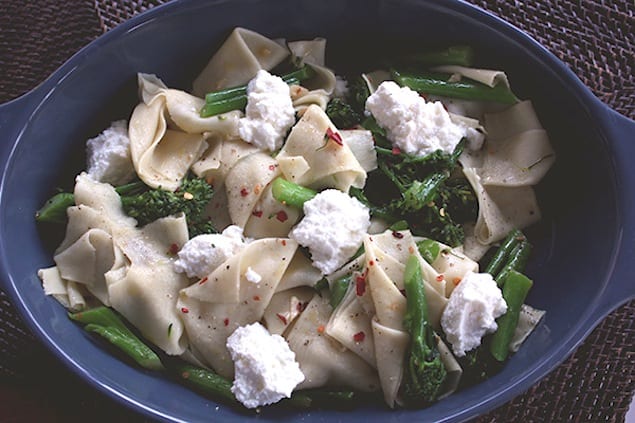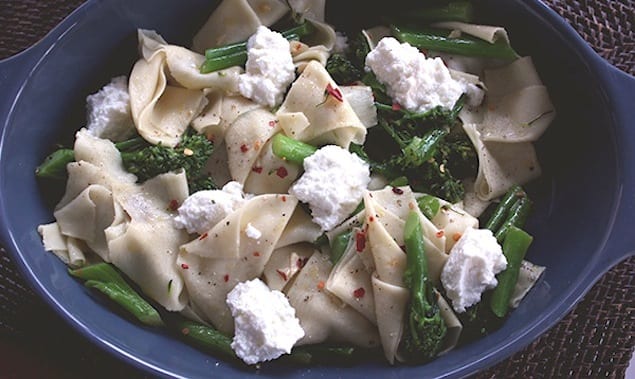Homemade pasta is rich and buoyant, paired with tender broccolini and fresh ricotta you will be eating like a spring king.
By Bowen Close

Fresh pasta! It doesn’t have to be so difficult. A food processor and a pasta machine make it fairly quick and easy work, and the finished product is absolutely worth the effort. Fresh pasta is rich and buoyant, a completely different experience than the dried grocery store variety – even the high-end brands – and the satisfaction that comes with having made something with your hands can fill in any of the meal’s empty spaces.
If you want to be a bit fussy about it, which I absolutely do not hold against you, there are things to be said about the type of flour you use and about rolling it out by hand and about getting your hands into the dough to knead it into submission. But if you’re looking for more fresh pasta in your life and need a place to get started, all you need is a bit of all-purpose flour, a few eggs, a food processor, and a pasta machine. Using a food processor reduces the mixing and kneading time down to just a few minutes, and the pasta machine will make quick and beautiful work of rolling out the dough to even the most paper-thin sheets. I’m a person who loves to have my hands on the food as much as I can, but to be honest I’ve gotten such a better product from using these two machines that I don’t really want to look back. For years I’ve had my eyes on the KitchenAid automatic pasta roller attachment for my stand mixer, but really the Norpro one we found years ago at Ross Dress for Less works perfectly fine.

And my favorite secret about fresh pasta? The less work you put into cutting it – the more basic the shapes, if you can even call them that – the more on-cue it seems. In this recipe, for instance, rolled out pasta sheets are cut roughly into squares, with no attention paid to straight lines or equal sizes. We call them “pasta handkerchiefs” and move on with our meal, and it all comes together as it should. Wide strips become pappardelle, or with a bit of filling and forming the sheets of pasta can easily become ravioli or agnolotti or caramelle.
I timed it once in preparation for teaching fresh pasta in a class, and from flour-to-pot the process took 1 hour for me to do alone, including 15 minutes for the dough to rest and 30 minutes for the cut pasta to rest. It will likely take you a few times to get it quite this quick, but considering that 45 minutes of that time can be spent doing other things – whether preparing the other parts of the dish or doing other things entirely – making fresh pasta suddenly becomes a lot more reasonable.
As with dried pasta, there is an infinite number of things you can do with fresh sheets of pasta. This winter I made fresh pasta fairly often to use for lasagna, which requires even less cutting than with handkerchiefs, and I’d guess that most commonly we make fresh pasta into pappardelle with ragu or roasted vegetables or some other sort of basic sauce.
Print
Fresh Pasta Handkerchiefs with Garlic Broccolini and Ricotta
- Yield: 2 1x
Description
Homemade pasta is rich and buoyant, paired with tender broccolini and fresh ricotta you will be eating like a spring king.
Ingredients
- 8 oz. broccolini (broccoli rabe works well here too)
- 1/4 lb. (4 oz.) fresh pasta handkerchiefs (see recipe below), OR uncooked lasagna sheets (conventional or no-boil)
- A few Tbsp. olive oil
- 3 garlic cloves, peeled and sliced or roughly chopped
- A pinch or two of red pepper flakes
- 1 small lemon for zest and juice
- Salt and pepper
- Around 1/2 cup room temperature ricotta
Fresh pasta in the food processor: Makes approximately 1/2 lb. of pasta, enough for 3-4 main dish servings
- 1 slightly heaping cup all-purpose flour, plus more for adjusting
- 2 large eggs
Instructions
Broccolini
- While preparing other ingredients, set a large pot of heavily salted water to boil. You’ll use this water to cook the broccolini and the pasta. Rinse the broccolini and cut each stalk into 3-4 sections or as needed to make comfortable bite-size pieces.
- Heat a large skillet over medium heat and add enough oil to lightly coat the bottom. Add the garlic and a pinch or two of red pepper flakes and cook over medium-low to medium heat, stirring occasionally and taking care not to burn or brown the garlic. When the water is boiling, add the broccolini and cook until mostly tender, around 3-4 minutes.
- Remove the broccolini using a slotted spoon or tongs and add it directly to the hot pan with the oil and garlic. Keep the pot on high heat and bring the water back to a boil before adding the pasta (see next step). Cook the broccolini until the cooking water has evaporated (or longer, if needed to make the it tender).
- Add the grated zest from half the lemon and salt to taste, and turn off the heat.
Pasta
- Add the cut fresh handkerchiefs or uncooked lasagna sheets to the boiling salted water and cook until tender – about 90 seconds for the fresh pasta or as directed on the package for the lasagna sheets. Drain, and if using the lasagna sheets cut them roughly into squares.
Assemble
- Toss the pasta squares with the broccolini in the skillet, squeezing in a bit of juice from the lemon and adding salt and freshly ground black pepper to taste, plus a bit more red pepper flakes if desired.
- Put in a serving dish or serve onto plates and add rough spoonfuls of fresh ricotta, nestling it amongst the pasta and broccolini.
Fresh Pasta
- Make dough Pour flour into the bowl of a food processor fitted with the blade. Add the eggs and run the machine until the two come together. Feel the dough – if it feels quite sticky, add a heaping teaspoon of flour and run the machine again. Repeat this process as needed until the dough feels more springy than sticky – it may still feel a little tacky and adhesive, but it shouldn’t stick to your fingers. The form the dough takes can differ batch-to-batch, but I’ve found that it usually forms mostly into a large ball when I first process it, then once I’ve added enough flour it breaks back into tiny bits (see pictures above). To note, once or twice I’ve ended up not having to add any extra flour – that’s okay. If the dough feels at all crumbly or like it won’t hold together into a mass, it’s probably too dry – add another egg and a another scant half cup of flour and increase your overall batch size.
- Knead and rest dough When the dough is the desired texture, put it on a counter, cutting board, or other work surface. Knead for about 1 minute, pushing it against the surface with the heel of your hand and using your entire hand to warm the dough as you work it. Wrap the dough in plastic and let sit at room temperature for 15 minutes to an hour. (For the recipe above where you only need half the dough, you can cut it in half at this point. Any unused dough or dough you want to roll out in the future can be wrapped well in plastic and frozen for up to 3 months at this point, if desired – thaw for 24 hours in the refrigerator and for an hour at room temperature before rolling out.)
- Roll out pasta Spread clean kitchen towels over a work surface, sprinkling them lightly with flour. Set your pasta roller at the largest opening. Cut the ball of dough into 6 pieces and pat each into a flat disk. Roll the first disk through the pasta machine. Fold it in thirds like a letter and roll through again (fold-down or open edge-down is fine). Repeat for a third rolling. Complete this process on all other pieces of dough. Now each piece will be rolled through the rest of the settings on your roller. Let the pieces rest on the kitchen towels between rollings, putting all pieces through setting #2 before starting #3, etc. If the pieces get too long, you can always cut them in half and continue rolling. Sheets may roll out quite wide or quite narrow, and either is fine. (In the pictures above the pieces rolled out quite narrow.) Roll through progressively thinner settings until you reach your desired thickness – my machine has 9 settings, and I usually roll until #8 unless I want very thin pasta. Let the pieces dry on the towels for 15-30 minutes before cutting and using.
- Cut pasta For handkerchiefs, cut the pasta roughly into squares or rectangles.
- Making ahead/storage: As noted above, unrolled pasta dough can be wrapped and frozen for up to 3 months. Rolled and cut pasta can also be prepared ahead of time – let the pieces dry for 15-30 minutes, then layer with kitchen towels and store at room temperature for up to 2 days or don’t include the kitchen towels and wrap in plastic or a zip-top plastic bag and freeze for up to 3 months. Frozen cut pasta can go directly into boiling water to cook.
- Category: Main














